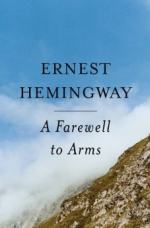|
This section contains 2,167 words (approx. 8 pages at 300 words per page) |

|
SOURCE: “Symbolism in A Farewell to Arms,” in English Studies, Vol. 53, December, 1972, pp. 518-22.
In the following essay, Carson explores the ways in which A Farewell to Arms fuses a naturalistic approach with compressed, symbolic language.
Edmund Wilson proclaimed in 1931 that the ‘literary history of our time is to a great extent that of the development of Symbolism and of its fusion or conflict with Naturalism.1’ History and the course of literary criticism have proved him correct. Strangely, however, he neglected all but passing mention of Ernest Hemingway, who had already demonstrated successful fusion of these elements in A Farewell to Arms.
Hemingway's naturalism is seldom questioned, but, despite the obvious allegorical significance of The Old Man and the Sea, his use of the symbol is still questioned.2 Hemingway had, nonetheless, already put into practice Mallarmé's dictum that ‘to name an object is to do away with...
|
This section contains 2,167 words (approx. 8 pages at 300 words per page) |

|


